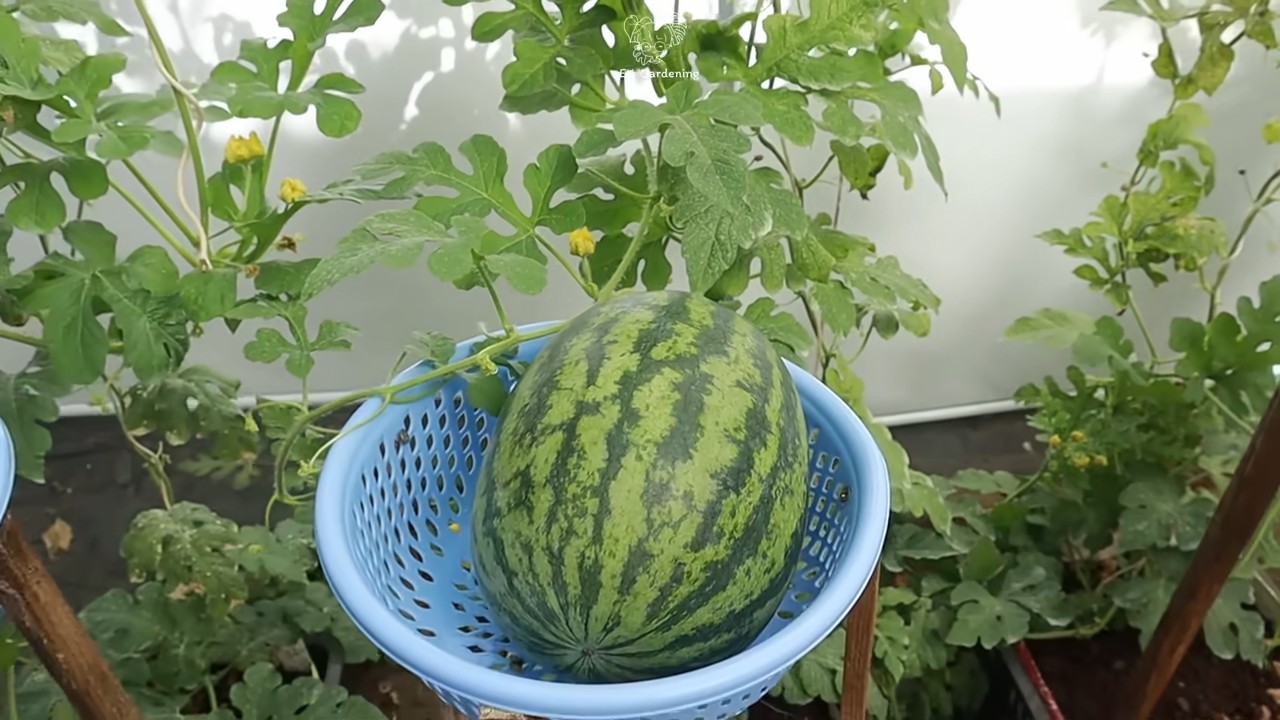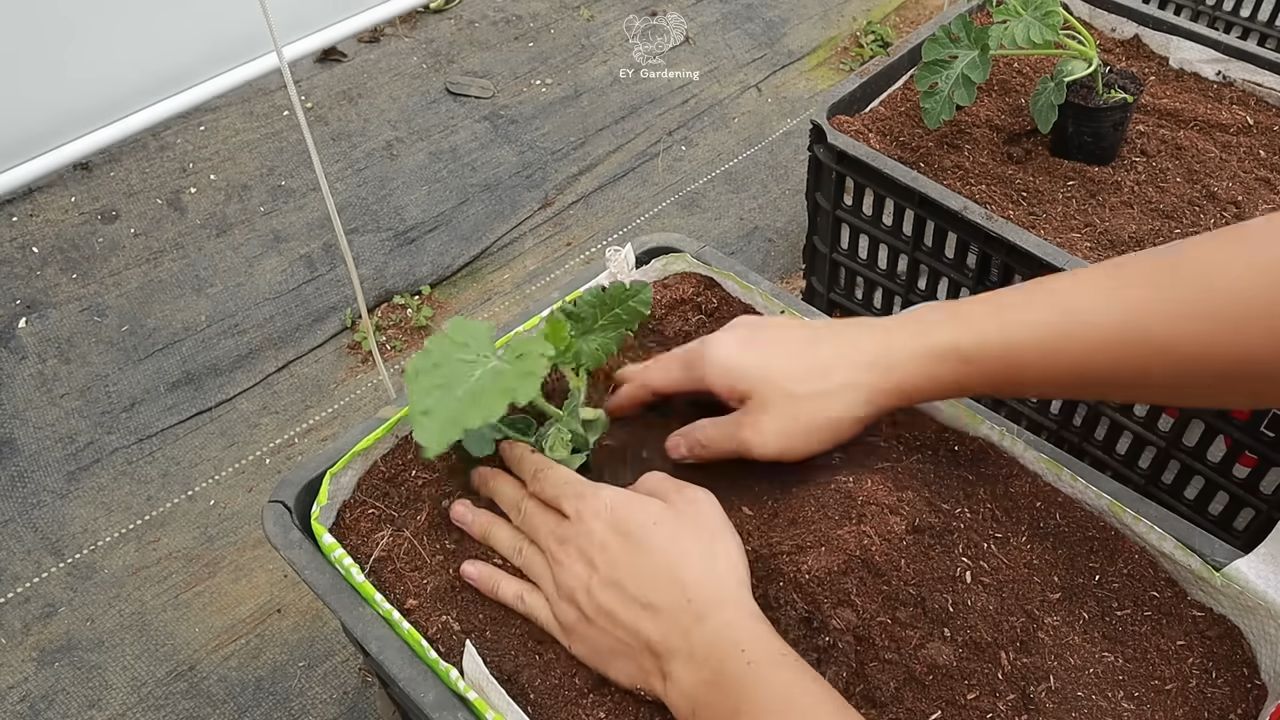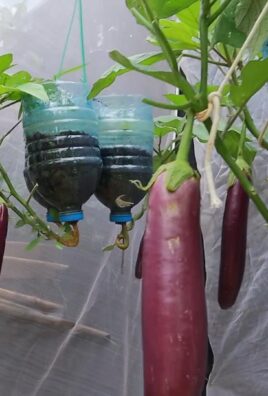Grow Watermelon Small Spaces? Absolutely! Dreaming of juicy, homegrown watermelon but think you don’t have the space? Think again! I’m here to tell you that even with a tiny balcony, a small patio, or just a sunny corner in your yard, you can absolutely cultivate these summer delights. This DIY guide is packed with clever tricks and hacks to help you enjoy the sweet taste of success, no sprawling field required.
Watermelons have a rich history, dating back thousands of years to Africa. They were even found in King Tut’s tomb! For centuries, they’ve been a symbol of summer, refreshment, and community gatherings. But traditionally, growing them meant dedicating a significant amount of land. That’s where our DIY magic comes in!
Let’s face it, not everyone has acres of farmland. Many of us are living in apartments, condos, or homes with limited outdoor space. But that shouldn’t stop us from enjoying the incredible satisfaction of growing our own food. This article will empower you to grow watermelon small spaces, offering practical solutions for container gardening, vertical growing, and choosing the right varieties. Imagine biting into a sweet, sun-ripened watermelon that you grew, right in your own little urban oasis. Ready to get started? Let’s dive in!

Growing Watermelons in Small Spaces: A DIY Guide to Vertical Gardening
Hey there, fellow gardening enthusiasts! Dreaming of juicy, homegrown watermelons but short on space? Don’t despair! I’m here to tell you that you *can* cultivate these summer delights even in the tiniest of gardens, balconies, or patios. The secret? Vertical gardening! I’ve successfully grown watermelons vertically for years, and I’m excited to share my tried-and-true method with you. Get ready to impress your friends and family with your watermelon-growing prowess!
Why Vertical Watermelon Gardening?
Before we dive into the how-to, let’s quickly touch on why vertical gardening is a game-changer for watermelon lovers with limited space:
* Space Saving: Obviously, this is the biggest benefit! By training your watermelon vines to grow upwards, you maximize your growing area and minimize the footprint.
* Improved Air Circulation: Vertical growth promotes better airflow around the leaves and fruits, reducing the risk of fungal diseases.
* Easier Pest Control: It’s much easier to spot and deal with pests when your plants are growing vertically and are more accessible.
* Sunlight Optimization: You can strategically position your vertical structure to ensure your watermelons receive ample sunlight.
* Aesthetic Appeal: Let’s be honest, a watermelon vine cascading down a trellis or archway is a beautiful sight!
What You’ll Need:
Here’s a list of everything you’ll need to embark on your vertical watermelon adventure:
* Watermelon Seeds or Seedlings: Choose a smaller variety like ‘Sugar Baby,’ ‘Bush Sugar Baby,’ ‘Golden Midget,’ or ‘Tiger Baby.’ These are better suited for vertical growing due to their smaller size and weight.
* Large Container: A minimum of 20 gallons is ideal. The bigger, the better, as watermelons need plenty of room for their roots to spread. I recommend using a durable plastic container or a half wine barrel.
* High-Quality Potting Mix: Use a well-draining potting mix rich in organic matter. Avoid using garden soil, as it can become compacted in containers.
* Trellis, Archway, or Sturdy Support Structure: This is crucial for supporting the weight of the vines and developing watermelons. A strong trellis made of wood or metal works well. You can also use an archway or even a sturdy tomato cage for smaller varieties.
* Soft Plant Ties or Pantyhose: These will be used to gently secure the vines to the support structure. Avoid using wire or anything that could damage the stems.
* Fertilizer: A balanced fertilizer (e.g., 10-10-10) and a bloom-boosting fertilizer (higher in phosphorus) are essential for healthy growth and fruit production.
* Watering Can or Hose: Watermelons need consistent watering, especially during hot weather.
* Support Slings (Optional but Recommended): As the watermelons grow, they can become quite heavy. Support slings made of fabric or netting will help prevent them from breaking off the vine. I often repurpose old t-shirts for this!
* Gloves: To protect your hands.
* Trowel: For planting.
Step-by-Step Guide to Vertical Watermelon Growing
Alright, let’s get our hands dirty! Here’s a detailed breakdown of the process:
1. Starting Your Watermelon Seeds (Optional)
If you’re starting from seeds, begin about 4-6 weeks before the last expected frost in your area.
1. Sow Seeds Indoors: Fill small pots or seed trays with seed-starting mix. Plant 2-3 seeds per pot, about ½ inch deep.
2. Keep Warm and Moist: Place the pots in a warm location (around 70-80°F) and keep the soil consistently moist. A heat mat can be helpful.
3. Provide Light: Once the seedlings emerge, provide them with plenty of light. A sunny windowsill or grow lights will work.
4. Thin Seedlings: Once the seedlings have a few true leaves, thin them to one strong seedling per pot.
5. Harden Off: Before transplanting outdoors, gradually acclimate the seedlings to outdoor conditions by placing them outside for increasing periods each day over the course of a week.
2. Preparing Your Container and Support Structure
This is a crucial step for setting your watermelons up for success.
1. Choose the Right Location: Select a sunny spot that receives at least 6-8 hours of direct sunlight per day.
2. Prepare the Container: Ensure your container has drainage holes. If not, drill some.
3. Fill with Potting Mix: Fill the container with high-quality potting mix, leaving a few inches of space at the top.
4. Install the Support Structure: Position your trellis, archway, or tomato cage securely in the container. Make sure it’s sturdy enough to support the weight of the mature vines and watermelons. I like to bury the base of my trellis a few inches into the soil for added stability.
3. Planting Your Watermelon Seedlings or Seeds
Now for the exciting part – getting your watermelons in the ground!
1. Transplant Seedlings (if applicable): Gently remove the seedlings from their pots and plant them in the center of the container, spacing them according to the variety’s recommendations (usually 1-2 plants per container for smaller varieties).
2. Plant Seeds Directly (if applicable): If you’re planting seeds directly, sow 2-3 seeds in the center of the container, about ½ inch deep. Thin to one strong seedling once they emerge.
3. Water Thoroughly: Water the newly planted seedlings or seeds thoroughly.
4. Training Your Watermelon Vines
This is where the vertical magic happens!
1. Guide the Vines: As the vines grow, gently guide them towards the support structure.
2. Secure with Ties: Use soft plant ties or strips of pantyhose to loosely attach the vines to the trellis or archway. Be careful not to tie them too tightly, as this can restrict growth.
3. Prune as Needed: Prune away any excessive side shoots or leaves to encourage the plant to focus its energy on fruit production. I usually remove any leaves that are yellowing or damaged.
4. Continue Training: Continue training the vines upwards as they grow, securing them to the support structure every few inches.
5. Watering and Fertilizing
Consistent watering and feeding are essential for healthy watermelon growth.
1. Water Regularly: Water deeply and regularly, especially during hot weather. Watermelons need consistent moisture to thrive. Check the soil moisture regularly and water when the top inch feels dry.
2. Fertilize Regularly: Feed your watermelons with a balanced fertilizer (e.g., 10-10-10) every 2-3 weeks. Once the plants start to flower, switch to a bloom-boosting fertilizer (higher in phosphorus) to encourage fruit production. Follow the instructions on the fertilizer packaging.
6. Supporting the Watermelons
As the watermelons grow, they’ll need extra support to prevent them from breaking off the vine.
1. Create Support Slings: Make support slings from fabric, netting, or old t-shirts.
2. Position the Slings: Position the slings underneath the developing watermelons, supporting their weight.
3. Secure the Slings: Secure the slings to the trellis or archway, ensuring they are strong enough to hold the weight of the mature watermelons. I like to use sturdy twine to tie the slings to the support structure.
7. Pest and Disease Control
Keep an eye out for pests and diseases and take action promptly.
1. Inspect Regularly: Regularly inspect your watermelon plants for signs of pests or diseases.
2. Common Pests: Common watermelon pests include aphids, squash bugs, and cucumber beetles.
3. Organic Pest Control: Use organic pest control methods such as insecticidal soap, neem oil, or hand-picking pests off the plants.
4. Preventative Measures: Encourage beneficial insects like ladybugs and lacewings to help control pests.
5. Common Diseases: Common watermelon diseases include powdery mildew and fungal leaf spots.
6. Fungicides: Use a fungicide if necessary, following the instructions on the packaging.
7. Good Air Circulation: Ensure good air circulation around the plants to help prevent diseases.
8. Harvesting Your Watermelons
The moment you’ve been waiting for!
1. Check for Ripeness: Watermelons are typically ready to harvest when the tendril closest to the fruit turns brown and dry,

Conclusion
So, there you have it! Growing watermelons in small spaces might seem like an impossible feat, but with a little ingenuity and the right techniques, you can absolutely enjoy the sweet taste of homegrown watermelon, even if you’re limited to a balcony, patio, or small garden. This DIY approach isn’t just about saving space; it’s about maximizing your yield, controlling the growing environment, and experiencing the sheer joy of nurturing a plant from seed to fruit.
Why is this a must-try? Because it empowers you to take control of your food source, reduce your reliance on store-bought produce (often shipped from far away), and connect with nature in a meaningful way. Plus, let’s be honest, there’s nothing quite like the bragging rights that come with serving a watermelon you grew yourself!
But don’t just take our word for it. We encourage you to experiment and find what works best for your specific environment and preferences. Consider these variations to personalize your watermelon-growing journey:
* **Vertical Gardening:** Explore different vertical structures like trellises, arbors, or even repurposed pallet gardens to maximize space and provide support for your growing watermelons.
* **Container Size and Material:** Experiment with different container sizes and materials (plastic, terracotta, fabric pots) to see which promotes the best root development and drainage.
* **Watermelon Varieties:** While smaller varieties are ideal, don’t be afraid to try different types of watermelon to find your favorite flavor and size. Look for bush or dwarf varieties specifically bred for container gardening.
* **Companion Planting:** Incorporate companion plants like basil, marigolds, or nasturtiums to deter pests and attract beneficial insects.
* Pollination Assistance: If you’re growing watermelons indoors or in an area with limited pollinators, learn how to hand-pollinate the female flowers to ensure fruit set.
Remember, growing watermelons in small spaces is a learning process. Don’t be discouraged if you encounter challenges along the way. Embrace the opportunity to learn, adapt, and refine your techniques. The reward of a juicy, homegrown watermelon is well worth the effort.
We’re confident that with a little planning and dedication, you can successfully grow watermelons in your limited space. Now it’s your turn! Give this DIY trick a try and share your experiences with us. We’d love to hear about your successes, challenges, and any tips you discover along the way. Share your photos and stories in the comments below, and let’s inspire others to embrace the joy of small-space gardening! Let us know what kind of **growing watermelon small spaces** techniques worked for you!
Frequently Asked Questions (FAQ)
What is the best type of watermelon to grow in a small space?
The best types of watermelons for small spaces are bush or dwarf varieties. These varieties are specifically bred to have shorter vines and smaller fruits, making them ideal for container gardening and limited spaces. Some popular choices include ‘Bush Sugar Baby,’ ‘Golden Midget,’ ‘Garden Baby,’ and ‘Yellow Doll.’ These varieties typically produce smaller watermelons (6-10 pounds) and mature relatively quickly. Avoid larger, vining varieties like ‘Charleston Gray’ or ‘Crimson Sweet,’ as they require significantly more space to grow.
How big of a container do I need to grow a watermelon?
A general rule of thumb is to use a container that is at least 24 inches in diameter and 18 inches deep. The larger the container, the better, as it will provide more room for the roots to grow and access nutrients. Ensure the container has adequate drainage holes to prevent waterlogging. Fabric pots are a great option as they allow for better aeration and drainage.
What kind of soil should I use for growing watermelons in containers?
Use a well-draining potting mix that is rich in organic matter. A good mix would consist of equal parts of compost, peat moss (or coconut coir), and perlite or vermiculite. Avoid using garden soil, as it can become compacted in containers and hinder drainage. You can also amend the potting mix with slow-release fertilizer to provide a steady supply of nutrients throughout the growing season.
How much sunlight do watermelons need?
Watermelons need at least 6-8 hours of direct sunlight per day to thrive. Choose a location that receives ample sunlight throughout the day. If you’re growing watermelons indoors, you may need to supplement with grow lights to provide sufficient light. Rotate the container regularly to ensure all sides of the plant receive equal sunlight.
How often should I water my watermelon plant?
Watermelons need consistent moisture, especially during hot weather. Water deeply whenever the top inch of soil feels dry to the touch. Avoid overwatering, as this can lead to root rot. Check the soil moisture regularly and adjust your watering schedule accordingly. During fruiting, watermelons require even more water to support fruit development.
How do I pollinate my watermelon flowers?
Watermelons have separate male and female flowers. Female flowers have a small, immature fruit at the base, while male flowers do not. If you’re growing watermelons indoors or in an area with limited pollinators, you may need to hand-pollinate the flowers. To do this, use a small brush or cotton swab to collect pollen from the male flower and transfer it to the stigma of the female flower. Hand-pollinate in the morning, when the flowers are open.
How do I know when my watermelon is ripe?
There are several indicators to look for when determining if a watermelon is ripe:
* **The tendril closest to the fruit turns brown and dries up.**
* **The bottom of the watermelon (where it rests on the ground) turns from white to a creamy yellow.**
* **The watermelon sounds hollow when you thump it.**
* **The skin becomes dull and less shiny.**
It may take some practice to accurately determine ripeness, but these indicators will help you get started.
Do I need to prune my watermelon plant?
Pruning can help improve air circulation and encourage fruit production. Remove any suckers (small shoots that grow from the base of the plant) and any yellowing or diseased leaves. You can also prune the vines to encourage the plant to focus its energy on fruit development. However, avoid excessive pruning, as this can reduce the plant’s ability to photosynthesize.
How do I support the watermelon fruit as it grows?
As the watermelon fruit grows larger, it may need support to prevent it from breaking the vine. You can use slings made from pantyhose, netting, or fabric to support the fruit. Tie the slings to a trellis or other support structure. This will help distribute the weight of the fruit and prevent it from falling off the vine.
What are some common pests and diseases that affect watermelons?
Some common pests that affect watermelons include aphids, squash bugs, and vine borers. Common diseases include powdery mildew, fusarium wilt, and anthracnose. Monitor your plants regularly for signs of pests or diseases and take appropriate action. Use organic pest control methods whenever possible, such as insecticidal soap or neem oil. Ensure good air circulation and avoid overwatering to prevent fungal diseases.
Can I grow watermelons indoors?
Yes, you can grow watermelons indoors, but it requires more effort and attention. You’ll need to provide adequate light (using grow lights), hand-pollinate the flowers, and ensure good air circulation. Choose a small, bush variety and use a large container. Growing watermelons indoors can be a rewarding experience, but it’s important to be prepared for the challenges involved.




Leave a Comment